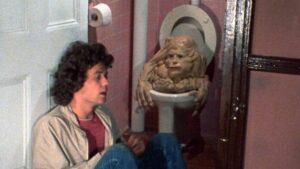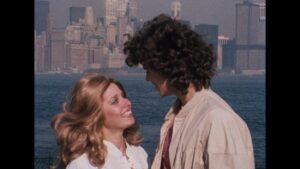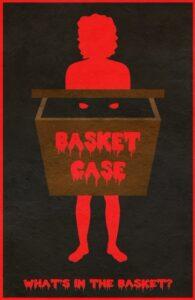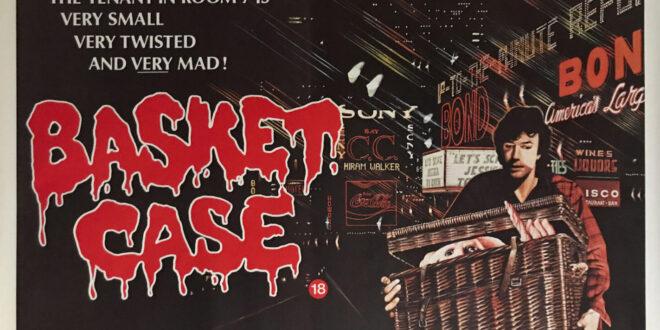This year marks the 40th anniversary of Frank Henenlotter’s Basket Case, one of the most punk rock cult classic horror films ever made. Released in April of 1982, Basket Case became an underground sensation. While it was a staple of the horror section in small town video stores across the country, the film’s setting is a far contrast from rural America.
When I think of New York, I think of The Ramones and Basket Case. The first is the band from Queens who brought punk rock to the masses, and the latter is a movie filmed in Times Square that showed how far an idea could go on a small budget. In the early 80s while the Ramones were in the studio having a gun pulled on them by record producer Phil Spector, Frank Henenlotter was crafting his cult masterpiece about a man name Dwayne and his detached, sexually deviant, portable, Siamese twin mutant brother, Belial. Dwayne (Kevin Van Hentenryck: Brain Damage 1986 – our retro review) carries Belial around the seedy streets of New York in a wicker basket, seeking revenge on the doctors who wronged them. They have a relationship similar to Garfield and Jon, except Belial craves violence rather than lasagna.
Times Square in New York used to be dirty and dangerous. It was far removed from the Dick Clark New Year’s Eve Special and the assortment of theaters that host popular plays and musicals. It is easy to forget that these streets were once lined with sex shops and peep shows. Basket Case is a time capsule of the place The New York Times once described as “the worst block in town.”
When Dwayne arrives on 42nd street with his infamous wicker basket—way better than a Baby Bjorn—he is approached by a drug dealer who says, “Smokes. I got joints and bags. Nickel and dime bags. Gold Columbia smoke. I got acid blotters, rainbows, window panes, speed, downs, Seconal, Valium, mescaline, THC. I’ve got some good cocaine. Quaaludes. Beauties. Methergine. Cheap Panama Red. Angel dust. Check it out, man. Tranquilizers, Antabuse, Lithium, Thai Sticks, Methadone, rock red, junk, Morphine. What do you want, some girls?” This sets the tone for this movie.

The line, “What’s in the basket?” is said by almost every other person Dwayne encounters. Those who find out the answer to this question typically meet a violent end. As the story progresses, Dwayne and Belial find refuge in the Hotel Broslin. They meet an assortment of characters, including a prostitute with a heart of gold named Casey (Beverly Bonner: Brain Damage 1986 – our retro review) and a thirsty, wig-wearing doctor’s receptionist named Sharon (Terri Susan Smith) who has the hots for Dwayne. He does go on a date with Sharon which causes Belial to erupt into a jealous rage. This leads to a climax that confused me as a kid (seriously, why was I watching movies like this?) and still confuses me now. If you’ve seen the movie, you have a pretty good idea of what scene I am talking about.
Basket Case is such a classic because of Frank Hennenlotter’s hard work and dedication. When Dwayne checks into the Hotel Broslin, the wad of cash he produces was the film’s entire budget and .Henenlotter’s life savings. There were times when they had to stop shooting to raise more money. The shooting process took nine months because of these stops.
Henenlotter also used his face to cast the Belial puppet and did the stop motion animation himself, despite not knowing how to do this. You can tell when you watch the movie by how disjointed it looks. He originally scrapped the stop motion animation segment because of this, but then put it back in because he thought it was hilarious. It’s one of those things that would not work in most movies, but is perfect for this one.
This work ethic is reminiscent of do-it-yourself punk rock bands who were inspired by The Ramones. They used to call them the Johnny Appleseeds of music because whenever they would play a show in a city, a dozen punk rock bands would sprout up, inspired by their performance. You can make the argument that Basket Case did the same thing for indie filmmakers. It showed that with enough heart, a classic could be made without the backing of a large studio.
The Ramones’ legacy was cemented long before they were inducted into the Rock and Roll Hall of Fame in 2002, just like the legacy of Basket Case was cemented long before the film was recognized and restored by The Museum of Modern Art in 2017. That’s right, the original negative of Basket Case is stored in the same room as the original negative of Gone With the Wind.
If you haven’t seen Basket Case, I highly recommend checking it out along with two sequels it spawned. This movie is the definition of a cult classic.

10 Fun Facts About Basket Case
- The original distributor for the film wanted to release it as a comedy movie and cut out all of the gore. Horror legend Joe Bob Briggs was one of the people who pushed to have the film released uncensored.
- Film critic Rex Reed hated the film and said it was the sickest movie he had ever seen. This line was quoted on the movie’s poster.
- Sharon, played by Terri Susan smith, is clearly wearing a wig throughout the movie. She was part of a punk rock band and had shaved her head shortly before filming began.
- The bar scenes were filmed in an S & M club in Manhattan called The Hellfire Club.
- The hotel in the movie does not exist, and they filmed the lobby shots inside a propped open service elevator.
- During the infamous death scene during the film’s climax, the crew was so offended that they walked off the set.
- Most of the names in the credits are fakes. The crew was small, and they decided to make up names rather than repeat the same ones over and over.
- Due to the film’s small budget, most of the furniture was found in dumpsters.
- The producer’s eight-year-old daughter performed the puppetry for Belial because the puppet shrank and was too small for adult hands.
- Frank Henenlotter claims he made this movie as a love letter to the Godfather of Gore, Herschell Gordon Lewis. He went on to make a documentary about H.G. Lewis in 2010.
Also, I made this minimalist poster for the movie:

 PopHorror Let's Get Scared
PopHorror Let's Get Scared




